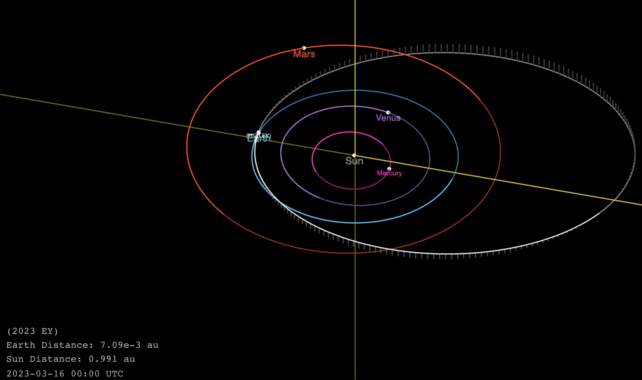As you read this, an asteroid similar in size to a house is approaching Earth, but there’s no need for concern. The recently discovered asteroid, named 2023 EY, will pass by our planet either late Thursday or early Friday, depending on your location. It will fly by at a distance of roughly 240,000 kilometers (149,000 miles), which is slightly less than two-thirds of the distance between Earth and the Moon.

Despite the asteroid 2023 EY passing by Earth at a distance of roughly two-thirds the distance of the Moon, which may seem uncomfortably close, there is no cause for concern as the asteroid, measuring just 16 meters (52 feet) in diameter, poses no threat to us. Unlike the Chelyabinsk meteor, which caused injuries due to its shock wave when it exploded over Siberia in 2013, 2023 EY won’t even enter our atmosphere. However, its proximity presents an exciting opportunity to observe it through telescopes. Although it won’t be visible to the naked eye, the Virtual Telescope Project will live stream the asteroid’s flyby starting at 00:00 UTC on Friday, March 17. The footage will be captured by a 17-inch robotic telescope in Ceccano, central Italy, with the closest approach expected to occur at 00:35 UTC on the same day. The live stream can be viewed below.
It’s fascinating to note that the asteroid, 2023 EY, was only discovered on Monday, March 13, thanks to the ATLAS (Asteroid Terrestrial-impact Last Alert System) network. The Sutherland Observing Station in South Africa, which is part of the ATLAS network, first spotted the asteroid. Established by the University of Hawaii and funded by NASA, ATLAS aims to provide early warning for potential asteroid impacts by utilizing telescopes in Hawaii, Chile, and South Africa. With the recent success of the DART mission, which demonstrated that asteroids can be diverted from their path using rockets, advanced warning systems like ATLAS will be essential. 2023 EY is classified as an Apollo NEO (near-Earth object), which is the largest known group of NEOs, with 17,540 Apollo asteroids recorded as of February 2023.

Chart showing the position of 2023 EY at 00:00 UTC, Thursday March 16. (NASA)
The group of near-Earth objects that cross Earth’s orbit and have orbits larger than that of Earth’s around the Sun is called Apollo asteroids, named after the asteroid 1862 Apollo discovered by Karl Reinmuth in the 1930s. Around 17,540 Apollo asteroids are known, and nearly 2,000 of them are identified as potentially hazardous asteroids, which refers to objects with a size larger than about 150 meters and could come within 7.5 million kilometers (4.6 million miles) of Earth. Although 2023 EY is not in this size range, it is still included in NASA’s Asteroid Watch Dashboard because of its close proximity.
So, there is no need to worry. Instead, take a moment to enjoy the live stream of a significant space rock approaching close enough to wave at as it continues on its long journey around the Sun.
As you read this, an asteroid similar in size to a house is approaching Earth, but there’s no need for concern. The recently discovered asteroid, named 2023 EY, will pass by our planet either late Thursday or early Friday, depending on your location. It will fly by at a distance of roughly 240,000 kilometers (149,000 miles), which is slightly less than two-thirds of the distance between Earth and the Moon.

Despite the asteroid 2023 EY passing by Earth at a distance of roughly two-thirds the distance of the Moon, which may seem uncomfortably close, there is no cause for concern as the asteroid, measuring just 16 meters (52 feet) in diameter, poses no threat to us. Unlike the Chelyabinsk meteor, which caused injuries due to its shock wave when it exploded over Siberia in 2013, 2023 EY won’t even enter our atmosphere. However, its proximity presents an exciting opportunity to observe it through telescopes. Although it won’t be visible to the naked eye, the Virtual Telescope Project will live stream the asteroid’s flyby starting at 00:00 UTC on Friday, March 17. The footage will be captured by a 17-inch robotic telescope in Ceccano, central Italy, with the closest approach expected to occur at 00:35 UTC on the same day. The live stream can be viewed below.
It’s fascinating to note that the asteroid, 2023 EY, was only discovered on Monday, March 13, thanks to the ATLAS (Asteroid Terrestrial-impact Last Alert System) network. The Sutherland Observing Station in South Africa, which is part of the ATLAS network, first spotted the asteroid. Established by the University of Hawaii and funded by NASA, ATLAS aims to provide early warning for potential asteroid impacts by utilizing telescopes in Hawaii, Chile, and South Africa. With the recent success of the DART mission, which demonstrated that asteroids can be diverted from their path using rockets, advanced warning systems like ATLAS will be essential. 2023 EY is classified as an Apollo NEO (near-Earth object), which is the largest known group of NEOs, with 17,540 Apollo asteroids recorded as of February 2023.

Chart showing the position of 2023 EY at 00:00 UTC, Thursday March 16. (NASA)
The group of near-Earth objects that cross Earth’s orbit and have orbits larger than that of Earth’s around the Sun is called Apollo asteroids, named after the asteroid 1862 Apollo discovered by Karl Reinmuth in the 1930s. Around 17,540 Apollo asteroids are known, and nearly 2,000 of them are identified as potentially hazardous asteroids, which refers to objects with a size larger than about 150 meters and could come within 7.5 million kilometers (4.6 million miles) of Earth. Although 2023 EY is not in this size range, it is still included in NASA’s Asteroid Watch Dashboard because of its close proximity.
So, there is no need to worry. Instead, take a moment to enjoy the live stream of a significant space rock approaching close enough to wave at as it continues on its long journey around the Sun.

